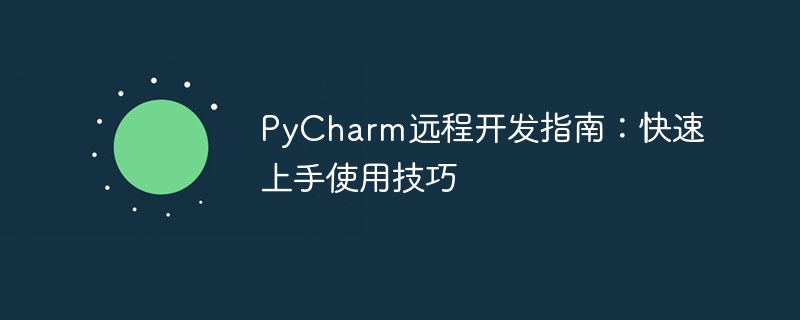

PyCharm is a powerful Python integrated development environment (IDE) that can be used to develop Python applications. In addition to using PyCharm in a local development environment, you can also use the remote development function to connect to a remote server or virtual machine to develop, debug, and run Python code in a remote environment. This article will introduce how to quickly get started using PyCharm remote development, and help readers better understand and apply this feature through specific code examples.
First, open PyCharm and create a new project. Select File -> Settings -> Project: [Project Name] -> Python Interpreter in the top menu bar, then click the gear icon in the upper right corner, and select Add in the pop-up menu , and then select SSH Interpreter. Fill in the relevant information of the remote server in the pop-up dialog box, including host name, user name, password, etc. Click OK to save the configuration.
After configuring the remote server, you can connect to the remote server in PyCharm through Tools -> Deployment -> Browse Remote Host, You can see the file directory structure of the remote server in PyCharm. Right-click the file you want to run on the remote server, select Open..., and then select Run... to run the code on the remote server.
PyCharm also supports debugging on remote servers. When running your code on a remote server, simply set breakpoints in your code and connect to the process on the remote server by clicking Run -> Attach to Local Process in PyCharm. In this way, the code on the remote server can be debugged in PyCharm.
In the remote development process, it is very important to use version control. PyCharm integrates multiple version control systems, such as Git, Mercurial, etc. You can easily perform code submission, pull, branch management and other operations in PyCharm to maintain code version control and team collaboration.
PyCharm also provides a file synchronization function, which can quickly and easily synchronize local files and remote server files. Automatic synchronization options can be set in PyCharm to maintain the consistency of local files and remote server files and improve development efficiency.
Through the above steps and techniques, you can quickly get started using PyCharm's remote development function. In actual development, not only can Python code be developed in the local environment, but also developed by connecting to a remote server, and functions such as remote debugging, version control, and file synchronization can be implemented to improve development efficiency and convenience.
In the process of applying these techniques, you will inevitably encounter some problems and challenges, but as long as you continue to learn and practice, I believe you can master the relevant skills of PyCharm remote development and apply them to actual projects. , improve your development capabilities and efficiency.
We hope that the PyCharm remote development guide provided in this article will be helpful to readers. Everyone is welcome to try and explore in practical applications and enjoy the convenience and fun of remote development.
The above is the detailed content of PyCharm Remote Development Guide: Quick Tips for Getting Started. For more information, please follow other related articles on the PHP Chinese website!
 How to change pycharm to Chinese
How to change pycharm to Chinese
 pycharm installation tutorial
pycharm installation tutorial
 How to solve the problem that pycharm cannot find the module
How to solve the problem that pycharm cannot find the module
 How to install pycharm
How to install pycharm
 The difference between python and pycharm
The difference between python and pycharm
 How to configure the pycharm environment
How to configure the pycharm environment
 How to install the pycharm interpreter
How to install the pycharm interpreter
 What does pycharm mean when running in parallel?
What does pycharm mean when running in parallel?




